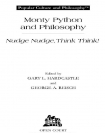Monty Python and Philosophy Gary Hardcastle (mystery books to read txt) 📖

- Author: Gary Hardcastle
Book online «Monty Python and Philosophy Gary Hardcastle (mystery books to read txt) 📖». Author Gary Hardcastle
CHAIRMAN: Now first of all I’d like to put this question to you please, lizard. How effective do you consider the lethal weapons employed by legal customs officers, nowadays?
(Shot of lizard; silence)
Well while you’re thinking about that, I’d like to bring the duck in here, and ask her . . . to clarify the whole question.
(Shot of duck; silence)
Perhaps the cat would rather answer that?
(Shot of cat; silence)
No?
Lizard?
(Shot of lizard again and then back)
No? . . .
What is it that’s so absurdly dear about the image of a duck, lizard, and cat sitting in chairs, being queried? And why is it that their absolutely unchanging expressions appear so sweet and goofy in this context?
What is endearing about the duck, cat, and lizard, I think, is that they haven’t got anything to say. What is utterly lovable about these animals is their muteness and indifference. They are not human; they do not babble endlessly. Surrounding them with chairs and microphones, placing them before a television camera-crew, the very incongruity of these things, of putting animals in this situation turns what isn’t exactly front-page news—animal muteness—into something absurd and laughable. At the same time, however, the incongruity and absurdity shows how what we mean by sitting, talking, thinking, and even having a face shifts from sense to nonsense depending on use.
Does It Sit on a Chair?
Take our concept of sitting, for example. We say that people, books, and paper sit, that they sit on desks or chairs, and that people and not books or papers sit down. But what does a lizard do? Does it sit on a chair like a book or like a person or neither?
Similarly, can you really talk to a duck? The concept of expressing , like the companion ideas thinking and gesturing, is enmeshed with our knowledge of the human body, especially the human face—its mouth, brows, eyes—and hands. The concept of expressing is bound up with the concept of having a face, and the concept having a face is bound up with having a human mouth and eyes and brows, that is, the sort that can express.
Given the interrelationship of concepts about faces and expression, it makes sense to describe a woman’s face as expressionless, but what can it mean to use these concepts of a duck? Does it make sense to say a duck is expressionless? And if not, can it make sense to say that they have faces?
Notice that we are no longer certain what having a face means: do we mean that ducks have faces in the sense that clocks do—as a front or surface—or what do we mean?
“But—They Simply Do Not Talk”
Let us consider a conventional philosophical question like “What is thinking?” A philosopher might believe that thinking causes talking, where talking is understood as the emission of meaningful sounds, the hard copy of thought, from our lips. Given the view that thinking causes talking, it might seem to follow that animals can’t think, since they evidently can’t talk. To this sort of reasoning Wittgenstein responds, in his Philosophical Investigations:
It is sometimes said that animals do not talk because they lack the mental capacity. And this means: “they do not think, and that is why they do not talk.” But—they simply do not talk. Or to put it better: they do not use language. . . . (Philosophical Investigations, §25)
In a nearby passage Wittgenstein says that if a lion could talk, we wouldn’t understand it. His objection in that passage, as well as the one above, is not based on disagreement over the facts: Wittgenstein isn’t trying to remind us of dolphins or apes as evidence that animals do talk and think. Rather, Wittgenstein is objecting to the tendency to ask questions like “What is thinking?” without acknowledging the infinitely many different uses of the concept thinking (in thinking aloud, being thoughtless, and so on) in their infinitely varied interrelationships with other concepts in our language. Ignorance of these complexities, he thinks, leads philosophers to generate a hairball of difficulties and puzzles.
“Is There Enough of It About?”
This brings us back to the philosopher’s cramp and “Spectrum: Talking About Things,” our opening sketch. How are we to explain the curious responses of the presenter and the cricketer: the presenter’s multiplication of questions, the cricketer’s near silence? The cricketer has a mental cramp; he assumes he’d heard a genuine question (‘What is going on?’) that he feels he should be able to answer, though he can’t think how. Though the presenter has also gotten a mental cramp, unlike his guest, he thinks that to meet the challenge he must press further, dig deeper, and soldier on.
Perhaps, like our presenter, philosophers take themselves and their work too seriously. Perhaps they need to get more laughs from the grueling work of philosophizing. But this is not how “Is There” ends. There, the presenter treats his work and the topics of the show as eminently serious and worthy of consideration. He closes the show saying:
On Is There next week we’ll be discussing the question ‘Is there enough of it about?’, and until then, goodnight.
Philosophers, no doubt, will tune in.
16
Why Is a Philosopher Like a Python? How Philosophical Examples Work
JAMES TAYLOR
Some people think that all philosophy departments should be closed down faster than a soiled budgie can fly out of a lavatory. It’s not hard to see why. After all, not only do philosophers typically dress worse than the Gumbys, but the way that they argue for their views seems exceptionally silly. When discussing practical moral issues such as abortion, euthanasia, or famine relief philosophers frequently come up with fantastic and far-fetched examples that don’t seem relevant to the case at





Comments (0)